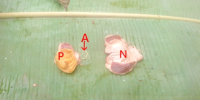A Case Report on <i>Ascaridia galli</i>-induced Gizzard Atrophy in Broiler Chicken (<i>Gallus gallus domesticus</i>)
Main Article Content
Abstract
Ascaridia galli, a nematode parasite, is the most prevalent nematode that causes gastrointestinal infections in birds. Some reports have stated that this nematode affects the intestines of birds; however, there is a lack of data on the effects of A. galli on gizzards. This study aimed to provide information on the presence of this parasite in the gizzards of broiler chickens. Three-months-old chicken (n=2) were purchased from a poultry farm. During evisceration, the gizzard of one bird was smaller in size. Further investigation showed that the small-sized gizzard was infected with A. galli upon necropsy. Ulcerative lesions were also observed in the mucosal layer. In conclusion, A. galli can attach to the walls of chicken gizzards to cause gizzard ulcers and atrophy.
Article Details

This work is licensed under a Creative Commons Attribution-NonCommercial-NoDerivatives 4.0 International License.
References
Ogbaje, C. I.,Agbo, E. O., &Ajanusi, O. J. (2012). Prevalence of Ascaridia galli, Heterakis gallinarum, and tapeworm infections in birds slaughtered in Makurdi Township. International Journal of Poultry Science, 11(2): 103-107. DOI: 10.3923/ijps.2012.103.107
Brar, R. S., Kumar, R., Leishangthem, G. D., Banga, H. S., Singh, N. D., & Singh, H. (2016). Ascaridia galli induced ulcerative proventriculitis in a poultry bird. Journal of Parasitic Diseases, 40(2): 562-564. https://doi.org/10.1007/s12639-014-0509-4
Bautista-Vanegas,A. L., Esteban-Mendoza, M. V., & Cala-Delgado, D. L. (2023).Ascaridia galli:Areport of erratic migration in eggs for human consumption in Bucaramanga, Colombia – case report. Arquivo Brasileiro de Medicina Veterinariae Zootecnia, 75 (1): 122-126. DOI:10.1590/1678-4162-12818
Proszkowiec-Weglarz, M. (2022). Gastrointestinal Anatomy and Physiology. In Scanes, C. G and Dridi, S. (Eds), Sturkie's Avian Physiology (7th ed., 485-527). Academic Press. https://doi.org/10.1016/B978-0-12- 819770-7.00010-4.
Inyang-Etoh, P. C., Udonkang, M. I., &Adedeboye,A. E. (2015). Occurrence of intestinal parasites among persons on highly active antiretroviral drug therapy in Calabar, Cross River State, Nigeria. Veterinary Science Development; 5: 5794. DOI:10.4081/VSD.2015.5794


